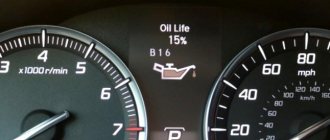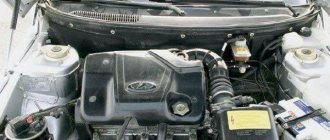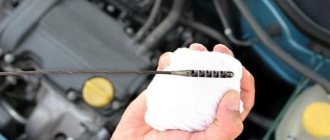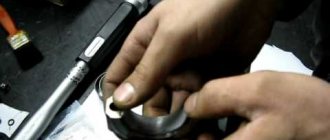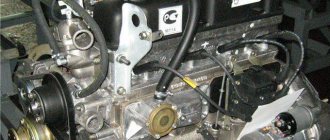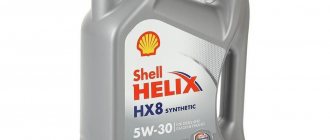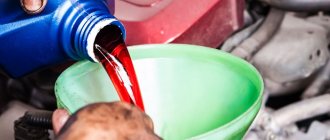Checking your car's oil level is essential to keeping it alive. This is one of the simplest types of regular machine maintenance that you can and should do yourself. And this is necessary not only because you would like to feel like a caring car owner, but because it is really important, and often the automaker shifts the burden of regularly checking the condition of the car onto the owner, including responsibility for failure to comply with such car maintenance measures.
Checking the oil is especially important before long trips that involve more intensive use of the engine. But how to properly check the engine oil?
Finding the dipstick
Check the oil level when the engine is cold. Mobil 1 and many other engine oil manufacturers recommend checking the engine oil level before driving the vehicle, while the oil is still cold. The bottom line is that the oil must drain into the oil pan from the engine compartment, otherwise, if not all the oil is in the pan, its level will be shown less than the real one, because it is in the pan that the oil level is checked. If you want to check the oil after driving the car, wait ten to fifteen minutes to allow it to drain into the oil pan.
In very cold weather, on the other hand, it may be advisable to start the car for a short time, then turn it off and also wait the same amount of time before checking the oil. You need to start the car so that the oil thins out a little (in severe frosts it thickens, which again may show incorrect values when checked).
However, on the dipsticks (a means of checking the oil level, more on this a little later) of most modern cars there are two pairs of marks, according to which you can check the oil level on both a cold and a hot engine. Accordingly, next to these marks there will be the words “Hot” or “Cold”.
Typical engine oil dipstick
So, park the car on a flat, level, horizontal surface. To get an accurate reading, you must ensure that the oil does not overflow onto one side of the pan, which can give you a slightly inaccurate test. Try to find a relatively flat horizontal surface and park on it. If the car is on a descent, then most likely it will give a false value, showing an overestimated oil level, and, conversely, if the car is on an ascent, then the oil will be less than it actually is.
Let's go under the hood. Most often, you can find the latch, which is used to open the hood, in the cabin in front of the driver's seat a little to the left - it usually looks like a lever; it actually shows the open hood. Pull this latch (or push, depending on the make and model of the car) and you will hear a characteristic click in the hood area.
Lever for opening the hood
Now you need to get out of the car to discover that the hood lid has opened slightly, and a gap has appeared between it and the car body. You will also find that something is preventing you from opening the hood, holding it dead. In the front middle of the hood lid, stick your fingers into this gap to find the lever, which, in fact, does not allow us to open the hood lid (sometimes the lever may be slightly offset from the center - just move your fingers along the gap, and you will definitely find it). Pull it and lift the hood. Thus, the engine compartment will be revealed to your eyes.
On some newer car models, the hood will remain open (the hood lid will not fall back and close), while on others you will need to secure the hood lid with a special rod, which is usually folded under the hood lip. Loosen one end of this rod and stick it into the special fixing hole in the hood.
Find the dipstick. On most cars, the oil level gauge will have a red, orange, or yellow (but in the vast majority of cases still yellow) cap on top, depending on the model. It is round or rectangular in shape, looks like a convenient handle to pull on and should stick out directly from the engine block.
It should be kept in mind that most automatic cars will have two dipsticks under the hood: one to check the engine oil and one to check the automatic transmission oil. The automatic transmission dipstick is usually located at the rear of the engine compartment or to the side of the engine (often on the driver's side), and the dipstick itself is much longer than the one found in the engine compartment. The dipstick handle is usually pink or red. The main thing is to never confuse these two dipsticks and thus not accidentally add engine oil to the gearbox and vice versa - gearbox oil to the engine - this can cost you serious money.
Find clean paper towels or old rags—preferably white or a light color.
Checking the oil level
Remove the dipstick. Most probes are about 25-35 centimeters long, but you will need to check the very tip to get what you are looking for. Slowly pull out the dipstick. It shouldn't be very difficult to pull, but you may have to use a little effort to get the dipstick handle out of the seal. Once the dipstick has moved just a little bit, it should pull fairly easily.
Examine the color and quality of the oil. The color and consistency of motor oil indicate its age, and possibly other engine performance issues. Once you remove the dipstick, you can get good information about the quality of the engine oil. Engine oil that is in good condition and does not need to be changed should appear yellow-brown, perhaps with a faint greenish tint on the dipstick. Under no circumstances should the oil be black - if it is black and opaque, then this is a signal to urgently replace it.
Now wipe the oil off the dipstick with a rag. The oil should change color, becoming darker and perhaps even black.
After you have wiped the dipstick, dip it again into the hole from where you pulled it out until the end - so that the probe handle enters the seal again with some effort. The first time you pull the dipstick, you won't be able to tell much about the quantity of oil, only the quality, since the dipstick will be covered in oil. Now, after you have wiped the end and inserted it back into the hole, pull it back out. Check the amount of oil. You will see two small dots on the end of most dipsticks: one dot represents the maximum oil level line in the oil pan, and the other represents the minimum. The minimum point should be closer to the tip of the dipstick, and the maximum should be about 3-5 centimeters above the minimum. In a properly filled engine with oil and under the correct oil testing conditions (remember, a horizontal surface and oil drained into the sump), the dipstick should become dirty with oil to a level approximately halfway between these two points.
If the oil line on the dipstick is below the minimum point, then it is necessary (and urgently) to add oil to the engine. The oil should also not be higher than the maximum fill point, although the oil level will be close to this point if the oil is checked with a hot engine.
We recommend: Reasons why the starter does not respond to turning the ignition key
Why and when to check
Whether you have a MAN truck or a passenger car, all installed internal combustion engines require filling with lubricating oil.
Over time, the oil is consumed and loses its physical and chemical characteristics. And then the lamp on the dashboard lights up, and the motorist thinks about the possibility of changing the lubricant in the crankcase in the near future. Whether he will do this using flushing oil or not is another question.
How to make a wheel alignment with your own hands: a simple technique
Category: DIY repairs
First the main questions. When and why? Checking the oil level makes it possible to control not only its quantity, but also its condition. Driving a car whose engine is cooled and lubricated with used oil can cause serious problems. This includes replacement of parts and even major repairs. That is, you don’t even need to ask why such a procedure is needed. It's more important to know when to do it. It is difficult to answer such a question correctly. In general, you should check it often.
It is especially important to make sure there is enough oil and in good condition if you are going on a long trip. Knowing from the marks what the correct level should be, you check with the current indicators. If you see that the amount is less than necessary, or the lubricant has become completely black, it is dangerous to drive far.
In everyday life, if you just drive a car to and from work, and also take your children to school, do shopping, then it is enough to check it at least once every 2 weeks. Some people do this more often, some later. Oil serves as one of the indicators of engine problems. Therefore, checking it will never be superfluous.
How often should you check the oil level in the system?
A low lubricant level in the engine should serve as a signal to take immediate action to correct the situation. Working parts and elements are subject to increased wear in cases where they are not covered with a sufficient amount of lubricant on all sides. All this threatens to lead to the need for early major repairs, and this, in turn, is a considerable expense.
Here is a video that once again confirms the need to check the oil. Here, engine diagnostics is the “oil slick” method.
Experienced car enthusiasts know that the oil in the system should be checked at least once every 2 weeks of operation. Even if the vehicle has been parked in a garage, this does not mean that the volume of lubricant in it remains unchanged. There is an inevitable leakage through various connecting fasteners, clamps, etc., as well as subsequent evaporation. Therefore, regular condition monitoring will prevent premature wear of the piston group elements. Operating a car with a lack of lubrication is especially dangerous for those who like sharp and dynamic driving or for those who live in mountainous areas. Even excess oil can pose certain dangers. In this case, excess penetrates into the cylinders and the crankcase ventilation system. Many cars today are equipped with a catalytic converter. An excess of oil will certainly end up in the exhaust gases along with the burnt fuel. Subsequently, this can lead to breakdown of the catalytic converter and the need to replace it.
Level checking algorithm
To check the level correctly, and also to understand the main points of the process, we present the verification algorithm as accessible as possible:
- To find out the actual oil level in the crankcase, it is very important Place the car on a completely flat surface. In the event that the engine tilts forward or backward, to the right or to the left, there can be no talk of any exact measurement.
Place the car on a level surface
- In no case should measurements be taken immediately after stopping the engine, since some of the oil will still be in the lubrication system and oil-conducting channels and, as a result, the level will be lower than the real one. In turn, this can confuse you and force you to add oil to the normal level, and after the oil drains into the crankcase, the level can rise critically, which will lead to squeezing of oil seals and other unpleasant things. After stopping the engine, at least 5-15 minutes should pass.
Let the car cool so that the oil drains into the crankcase. The arrow indicates the typical placement of the oil dipstick.
- We take out the dipstick and wipe it with a rag, since it will be splashed with oil. We immerse the dipstick back into the crankcase.
We wipe the dipstick with a rag.
A big mistake is to judge the level immediately after removing the dipstick. Control is carried out only after the dipstick is re-immersed in the crankcase.
- We find two marks on the dipstick - minimum and maximum. Normal level - the oil is between these two notches. Add oil only if the level is below the minimum or a few millimeters above it. It is also not advisable to keep the level at maximum.
Oil level is normalOne side of the dipstick may be labeled Cold and Hot.
It is worth remembering that in most engines with a full standard pan between the minimum and maximum on the dipstick, the total oil volume can range from 500 to 800 ml.
- If necessary, add oil, we check its quality by external signs: traces of coolant (so-called emulsion), excessively dark color, as well as loss of viscosity indicate either a malfunction or wear of the oil. In these cases, it is necessary to either eliminate the malfunction or replace the oil and oil filter.
When monitoring the engine oil level, it is necessary to check its quality
Additional nuances
The oil level should be checked as often as possible - at each refueling, during daily inspection, and if the car is operated periodically, then before each engine start. Adding oil should be done either on a cold or slightly warmed up engine so that after topping up the dipstick readings are as realistic as possible. In this case, topping up is carried out with the exact brand of oil that was filled in before, or the brand recommended by the manufacturer.
It is better to add oil on a cold engine.
How often should I check?
The frequency of checking depends on the condition of the engine. But the frequency of oil changes greatly depends on the brand of engine, its power and design features. For example, for low-speed, low-power engines, the normal replacement period may be 15 thousand km , but the regulations also depend on the quality of the lubricant.
In this case, you should be guided not so much by the regulations specified by the manufacturer, but by the results of the level check. Black and too thin oil on the dipstick is the first reason to change the lubricant and filter. Maintain your engine correctly and in a timely manner, good luck to everyone and your engine's millionth mileage!
What and how is the level checked?
The measurement is made with a dipstick to check the oil level in the engine - this is a special rod with two marks at the end - “min” and “max”. The oil dipstick handle on all engines is placed in a clearly visible place (usually near the cylinder head) and is painted in a bright color, so it is difficult not to notice it.
The technology for checking the lubricant level in the engine for “cold” and “hot” is almost identical and includes the same algorithm of actions.
All you need to check the level correctly is a clean, lint-free rag. Let's consider the work algorithm using the example of checking on a cold engine:
- We place the car on a flat horizontal platform.
- Open the hood and find the dipstick handle.
- Pull out the oil dipstick completely.
- Wipe off the grease from the tip of the rod with a rag.
- Install the dipstick until it stops.
- After 3-5 seconds. We pull out the rod again and evaluate the level using the trace of lubricant.
As for the “hot” check, the algorithm of actions is the same, but after placing the car on a flat surface, you need to wait time (5-10 minutes) to lubricate the glass in the pan and only then check the level.
The oil level on the dipstick is considered normal when it is between o and “max”, preferably 2/3 of the minimum. If the level on the dipstick is close to one of the marks, this is not a problem and you can safely operate the car. Although if it is noticed that the level is approaching o, then it is worth adding oil.
The oil level must be checked either only “cold” or “hot”. Using both methods at the same time can confuse the determination of the amount of oil and then topping up will be done incorrectly.
Checking the oil level in a car engine
Determining the oil level in an internal combustion engine is not a difficult job, but it requires certain knowledge. It is necessary to check to avoid the mark level falling below the maximum permissible level and exceeding the maximum permissible mark level. If the engine oil level goes beyond the markings, it will affect the operation of the internal combustion engine and the overhaul period.
The dipstick is located in an accessible place on all engines so that you can check it in clean clothes without getting dirty. The dipstick has a dense rubber gasket that ensures tightness.
We recommend: Semi-automatic transmission, operating principle.
Possible consequences of lack of oil
An insufficient amount of lubricant in any device that involves intense friction is more destructive than its excess. And the more the engine oil level deviates from the standard value, the more serious the consequences will be.
The lubrication system of the vast majority of modern combined-type power units. Motor oil is supplied to the rubbing surfaces in two ways: by a jet under pressure from the line, where the pressure is created by the pump, and by splashing during rotation of the crankshaft and camshaft.
Timely checking the engine oil level and topping it up to the required level, first of all, ensures that the spray mechanism is maintained.
If the volume of lubricant drops to a critically low level, when forced circulation begins to fail, a notification about this will immediately appear on the dashboard.
Let's look at the main problems that will not take long to appear if the engine contains less than the required amount of lubricant.
- accelerated wear of rubbing surfaces, especially those related to the cylinder-piston group;
- disturbed thermal balance, which will lead to local overheating of some engine parts;
- possible jamming of the motor due to overheating or unacceptable wear.
It is necessary to check the engine oil on time (at least once a week) and according to technology that allows you to correctly evaluate the readings obtained.
When to check the level
Checking the engine oil level is necessary in the following situations:
- Some time later. Even if the car was constantly parked in the garage, there is a high probability of leaks caused by abrasion of gaskets, failure of seals and hose joints. Therefore, a weekly check won't hurt.
- After walking long distances. General recommendations for any car are to check the engine oil level every 1-2 thousand km. However, certain car manufacturers have their own instructions.
- If you are planning long trips.
- When purchasing a vehicle secondhand, or after it has been idle for a long time.
- If the coolant level suddenly changes.
- If problems arise in the functioning of the motor. Evidence of malfunctions is extraneous knocks, noises, a decrease in traction, or, on the contrary, an increase in it, the appearance of an unpleasant odor in the cabin, an increase/decrease in pressure.
- When a puddle of oil forms under the iron horse, take measurements.
- The older the car, the more often you need to check the oil level in the engine.
Oil residues on the dipstick indicate a changing amount of oil in the engine chamber.
Why is it wrong to check the oil “cold”?
First of all, you should remember the following when carrying out such an operation:
- At low temperatures, the oil thickens greatly and a depression may form where the surface is “punctured” by the dipstick. As a result of such a “deflection” of the lubricant, it will cover the dipstick significantly below the actual level.
- If the car has been parked for too long, then most of the oil in the line and on the walls of the pistons and crankcase will flow down. For this reason, after measuring the level, the driver may consider the oil level to be normal (it will be at the min mark), but after the engine is started, the lubricant level may decrease significantly, which can cause oil starvation of parts lubricated under high pressure.
For these reasons, it is not recommended to check the oil level “cold”, but after a short period of engine operation, it is also necessary to carry out a control operation in compliance with certain rules.
If the level is above the maximum
When excess oil remains in the engine for a long time, many problems arise, including complete engine failure.
Reasons why the phenomenon occurs
- Overfilling when changing oil;
- Incorrectly selected fluid viscosity;
Consequences
- On older cars, increased fluid levels can squeeze out seals and gaskets;
- Loss of power;
- Failure of the idle speed controller and other electronic sensors is possible due to oil getting on them on injection vehicles;
- Damage to spark plugs;
- Oil getting into the cylinders.
Ways to eliminate overflow
In case of oil overflow, there are two options:
- Contact the service station. The craftsmen will drain the excess oil.
- Drain off excess oil yourself. To do this, after the engine has cooled, you need to unscrew the drain plug (it is located at the bottom of the crankcase - you will have to use a lift, pit or overpass) and let the excess oil drain out. Sometimes it is enough to pump out the excess with a syringe.
Pumping out with a syringe is a task for a car enthusiast with a level above a beginner
Basic recommendations
There are a few basic tips that you should definitely follow when checking your oil level. And here it doesn’t matter at all what kind of car you have.
These rules apply equally to vehicles such as:
- Nissan Teana;
- Kia LED;
- Mercedes 211;
- Audi A4;
- Honda SRV;
- BMW;
- Hyundai Sonata;
- Skoda Octavia;
- Nissan Beetle;
- Volkswagen Polo sedan;
- Lada Priora 16 valves, etc.
That is, any motor that uses an internal combustion engine.
In winter and summer, it is important to fill in the engine oil that is optimally suited to the requirements of the car manufacturer and weather conditions. Here, by the way, it will be important to remember about warming up the engine. Whether you need to do this or not, you will find out by following the link to our previous material.
In order to avoid mistakes and not receive incorrect data when checking the amount of lubricant in the crankcase, I advise you to start by studying simple 5 rules.
If you have additional recommendations on this matter, be sure to write in the comments. Perhaps you know some special and interesting life hacks.
Trailer Vodnik: modifications, sizes, price, owner reviews
Category: Light trailers
- To ensure the correct oil level, use level surfaces to check. Any deviation to the side will cause the probe to not show the true value;
- On which engine do you think the measurements will show the correct value? That's right, warmed up. Therefore, the motor is first heated to operating temperature;
- All oil should drain back into the crankcase. If you just drove into the garage or stopped in a parking lot, do not rush to insert the dipstick. A lot of oil is still in the system and has not had time to drain down. After all, after pressing the Start Stop button or turning the ignition key, the oil begins to be distributed throughout the engine. When the engine stops, the lubricant flows back into the crankcase;
- To correctly assess the amount of lubricant, use the original dipstick. There is no point in trying to make some kind of wire or homemade probe.
As for me, the tips, although simple, are extremely important. Without following these recommendations, you will definitely not be able to find out the real level of lubricant in the engine. Therefore, you may encounter additional problems in the future.
How to correctly determine the oil level
At first glance, such a trivial task as checking the oil level can cause certain difficulties and anxiety for the owner - this can include a sudden increase in the level, a drop, or a change in the characteristics of the oil. All this can be tracked if the check is carried out properly and knowledgeably. In any engine, checking is carried out using a dipstick , which is always located in an area of easy access. It is inserted into a sealed hole in the cylinder block, and the other end is immersed in an oil bath in the engine crankcase.
Checking the oil level
Features of the oil dipstick
Each dipstick, regardless of the engine model, has two marks - the maximum and minimum lubrication level. However, there are certain conditions under which the probe readings may be incorrect. To minimize the impact of these conditions and determine the amount of oil in the engine crankcase as accurately as possible, you must use the simple rules outlined below.
Basic rules for changing oil
Before you begin this operation, there are several important steps you should take as part of your preparation. The necessary information about the oil fluid, which will correspond to the characteristics of a particular car, can be found in several ways.
It is often contained in the operation and repair manual that comes with the vehicle. In the area of the top of the engine there is a cap that may also indicate the type of oil suitable for that engine. In the case where such data is not available, you need to independently pay attention to the features of a particular machine, and only then decide on the purchase of oil fluid.
This issue should be approached with particular scrupulousness, since due to the abundance of types and brands, the choice may not be easy.
Before replacing, it is recommended to warm up the engine well and use a vacuum suction, otherwise there is a risk of leaving 300 to 500 g of old oil, and when filling in new oil, you can get an overflow. It is important to ensure that the watering can used to top up is clean, since the ingress of foreign impurities is strictly undesirable, as a result of which the oil filters will clog much faster.
Replenishing oil volume is a slow and measured process. Filling should be done not in one continuous stream, but at certain intervals. Adding portions gives time for the oil to settle in the crankcase.
Note! It is necessary to avoid getting liquid directly on the engine itself, since when it heats up, the oil will begin to smoke, leaving a pungent burning smell that can seep into the interior of the car.
After the procedure, a control measurement of the level is carried out according to the same rules as the first check.
How to measure the oil level correctly
The oil level on the dipstick rod may vary. Therefore, in order to accurately determine how much oil is in the internal combustion engine, you must follow the following recommendations:
- Park the car on level ground. After all, if the car is parked on a slope on either side, the oil in the crankcase will accumulate in one corner and the dipstick will show a low oil level.
- Do not measure the level “hot”, that is, after the engine has been running, you must let it cool.
I think everyone knows that when heated, substances increase in volume. If you measure when the engine is hot, the level will show more than real. There are marks on the automatic transmission dipsticks when the oil level should be at the HOT mark (when the automatic transmission is hot) and at the COOL mark (when the automatic transmission is cold). Convenient, no need to wait for it to cool down. - We take out the dipstick and wipe it with a clean rag. It can only be determined accurately after repeated immersion in oil.
- Insert the dipstick into place into the crankcase all the way.
- We look at where the oil ends on the dipstick and where this level is. The normal level is the “golden mean”, between the min and max marks.
- If the level is below the minimum mark or close to it, then you need to add oil. The engine oil must be exactly the same as that which was filled. If, for example, Lukoil oil marked 5w-40 is poured, then fill in the same. If synthetic oil was added and mineral or semi-synthetic oil was added, the oil will react and curdle, after which you will have to completely drain the oil, flush the internal combustion engine system, buy new oil and refill.
- If the level is above the maximum mark or close to it, then the best option would be to drain some of the oil by unscrewing the drain bolt at the bottom of the crankcase. If you do not do this, you may squeeze out the seals, which will have to be replaced later.
The volume between the min and max marks is approximately 500-900 ml, depending on the engine size.
When checking the oil level, you must also check the quality of the oil. You can see from the oil on the dipstick whether it is transparent or not. It happens that the oil is completely black. In this case, of course, you should replace it immediately.
When changing the oil, the oil filter must also be changed. If after changing the oil and filter, the oil pressure icon on the instrument panel lights up and does not go out, then you need to unscrew the oil filter and screw it back in (there is an air lock in the oil filter), although a little oil will leak out, but this is not critical, I think. If the oil filter, volume and characteristics of the oil are responsible for the oil pressure in the system, then the fuel pressure regulator (FPR) is responsible for the fuel pressure supplied to the injectors.
How often to check the engine oil level
Different engines have different operating instructions. In addition, the oil change period depends on the quality of the oil itself.
For low-speed, low-power engines, the normal mileage for oil changes is 15,000 km. As for replacing the fuel filter, its service life is 60,000 km or varies according to the degree of contamination.
What motor oils should you use?
The service life of the engine and its performance characteristics depend on the choice of oil, so you should not take the first engine oil you come across. When choosing a lubricant, many factors need to be taken into account:
- climatic conditions in which the car will be operated;
- driver's driving style;
- degree of wear of the unit;
- car mileage;
- motor design features.
The main parameters of the lubricating fluid are indicated in the operating instructions for the specific vehicle. Based on data from the manual and advice from experts, in the TopDetal.ru online store you can buy motor oil that will be most suitable for your car.
Consequences of excess oil in the engine
There is an opinion that a slight excess of lubricant is better than its lack. And some drivers, whose cars already have a decent mileage and the engine consumes quite a large amount of oil due to waste, fill it in for future use so as not to top it up every 500–1000 km.
Often the cause of an excess amount of lubricant in the crankcase is the car owner’s insufficient knowledge of how to check the oil level and evaluate the measurement results obtained. Let's consider the main consequences of excess:
- Squeezing out lubricant through the channel for installing the dipstick and the crankcase drainage system, as well as getting it into the intake manifold if the engine provides a connection between the breather and the power system.
- Difficulty starting the engine in winter after a long period of inactivity. Any lubricant thickens in winter. And if the engine oil reaches the crankshaft, it becomes problematic and sometimes impossible for the starter to turn the engine in the thickened lubricant.
- Squeezing out oil seals. This problem occurs due to a combination of factors: the volume of lubricant exceeds the permissible norm and the crankcase ventilation system is blocked. Internal pressure pushes through the sealing collars.
Therefore, excessive oil level in the engine can cause serious harm. And if it happens that more oil was accidentally poured in than necessary, it is better to drain the excess amount through the plug on the pan or pump it out in any other way.
What should the engine oil level be?
The correct engine oil level depends primarily on what kind of iron horse you ride. Thus, domestically produced vehicles require on average about 4 liters. Such figures are approximate for engines whose volume reaches 1.8-2.4 liters. A larger power plant will require more lubrication.
In order not to make mistakes with the indicators, initially fill in about 3.5 liters. Next, check the engine oil level using a dipstick. If the lubricant is still not enough, then add no more than 200-250 g and take measurements again. This procedure is carried out continuously until the sensors show the normal oil level in the engine.
With passenger cars produced abroad, things are somewhat different. So, a 2.4 liter engine will require at least 4.2-4.3 liters of oil. In this case, you will not need to purchase 5 liters of liquid, because you will not be able to drain the remainder, and some volume should remain. Therefore, you will only have to top up.
The orange handle in the engine compartment is a “dipstick” for checking the oil level in the engine.
Low oil level
Few drivers will undertake to answer what is more dangerous for the engine: underfilling or overfilling
Causes
- Wear of oil seals and seals;
- Underfilling when replacing;
- Increased oil consumption caused by a malfunction of the oil level sensor or other factors (most often a faulty engine simply eats oil);
- Aggressive driving style.
What happens if you don't fill it on time?
- Engine oil starvation;
- Scoring on the cylinder walls and other mechanical damage;
- Engine overheating.
How to increase your performance
This problem can be corrected by adding oil. If seals and gaskets are worn, they should be replaced.
Consequences of overfilling and underfilling oil
Excess fluid affects not only the technical characteristics of the engine, but also the cost of subsequent repairs. The emerging changes are dangerous due to their gradualness and imperceptibility in the early stages. Overfilling can result in the following:
- If the level is excessively high, there is a possibility that the crankshaft counterweights will become immersed in oil and foaming may occur. Possible problems in this case cannot be predicted.
- At a critically high level, splashes fall on the spark plugs and, as a result, the engine power decreases and the ignition system is disrupted.
- Grease may settle on the air filter.
Consequences of oil overflow - Due to the increased pressure, the crankshaft oil seal may begin to squeeze out, which will also increase the cost of subsequent repairs.
- Low ambient temperatures begin to make it difficult to start the engine.
- Difficulty in rotating the crankshaft due to overflow leads to poor speed acceleration. The driver, seeing an insufficient response to pressing the gas, begins to press the pedal harder, which leads to increased fuel consumption.
Remember! The oil should not be allowed to drop below the critical line. In this case, overheating will be ensured.
In addition, reducing the amount of lubricant exposes parts to faster wear due to increased friction between them. The consequences themselves may be as follows:
- Wear of parts leads to increased consumption of lubricating fluid.
- Rotating bearings cause damage to the drive structure.
- Possible engine wedge.
- Without lubrication, scratches appear on the cylinder walls. And boring, as a result, threatens the need for major repairs.
- The oil pump elements may become jammed. In this case, there is only one correct way out - its complete replacement.
- Metal shavings enter the cylinder head, which entails wear and tear of the entire engine.
These reasons are a reliable argument in favor of regular inspections.
